-
【数据结构】队列-Queue
⭐ 作者:小胡_不糊涂
🌱 作者主页:小胡_不糊涂的个人主页
📀 收录专栏:浅谈数据结构
💖 持续更文,关注博主少走弯路,谢谢大家支持 💖

1.什么是队列
队列: 只允许在一端进行插入数据操作,在另一端进行删除数据操作的特殊线性表,队列具有先进先出FIFO(FirstIn First Out) 入队列:进行插入操作的一端称为队尾(Tail/Rear)出队列:进行删除操作的一端称为队头(Head/Front)

2. 队列的使用
在Java中,Queue是个接口,底层是通过链表实现的:

方法 功能 boolean offer(E e) 入队列 E poll() 出队列 peek() 获取队头元素 int size() 获取队列中有效元素个数 boolean isEmpty() 检测队列是否为空 Queue是个接口,在实例化时必须实例化LinkedList的对象,因为LinkedList实现了Queue接口。上述方法的实现:
import java.util.LinkedList; import java.util.Queue; public class Main { //方法的实现 public static void main(String[] args) { Queue<Integer> q = new LinkedList<>(); q.offer(1); q.offer(2); q.offer(3); q.offer(4); q.offer(5); // 从队尾入队列 System.out.println(q.size()); System.out.println(q.peek()); // 获取队头元素 q.poll(); System.out.println(q.poll()); // 从队头出队列,并将删除的元素返回 if(q.isEmpty()){ System.out.println("队列空"); }else{ System.out.println(q.size()); } } }- 1
- 2
- 3
- 4
- 5
- 6
- 7
- 8
- 9
- 10
- 11
- 12
- 13
- 14
- 15
- 16
- 17
- 18
- 19
- 20
- 21
- 22
3. 队列的模拟实现
我们知道队列中既然可以存储元素,那底层肯定要有能够保存元素的空间,通过线性表可以了解到常见的空间类型有两种:顺序结构和链式结构。
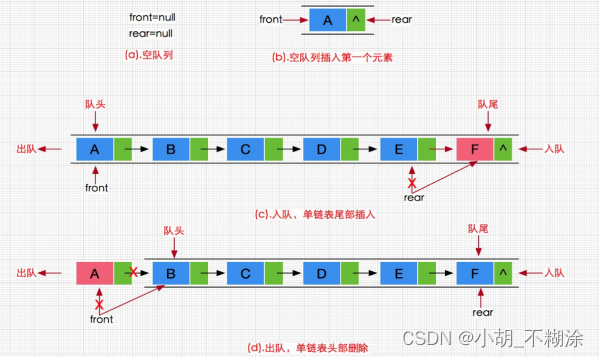
模拟实现队列:public class MyQueue { //双向链表节点 static class ListNode { public int val; public ListNode next; public ListNode prev; public ListNode(int val) { this.val = val; } } public ListNode head;//队头 public ListNode last;//队尾 public int usedSize;//队列元素个数 // 入队列---向双向链表位置插入新节点 public boolean offer(int val) { ListNode node = new ListNode(val); if(head == null) { head = node; last = node; }else { last.next = node; node.prev = last; last = last.next; } usedSize++; return true; } // 出队列---将双向链表第一个节点删除掉 // 1. 队列为空 // 2. 队列中只有一个元素----链表中只有一个节点---直接删除 // 3. 队列中有多个元素---链表中有多个节点----将第一个节点删除 public int poll() { if(head == null) { return -1; } int retVal = head.val; if(head.next == null) { head = null; last = null; return retVal; } head = head.next; head.prev = null;//第一个节点删除 usedSize--; return retVal; } // 获取队头元素---获取链表中第一个节点的值域 public int peek() { if(head == null) { return -1; } return head.val; } public boolean empty() { return head == null; } public int size() { return usedSize;- 1
- 2
- 3
- 4
- 5
- 6
- 7
- 8
- 9
- 10
- 11
- 12
- 13
- 14
- 15
- 16
- 17
- 18
- 19
- 20
- 21
- 22
- 23
- 24
- 25
- 26
- 27
- 28
- 29
- 30
- 31
- 32
- 33
- 34
- 35
- 36
- 37
- 38
- 39
- 40
- 41
- 42
- 43
- 44
- 45
- 46
- 47
- 48
- 49
- 50
- 51
- 52
- 53
- 54
- 55
- 56
- 57
- 58
- 59
- 60
- 61
- 62
- 63
- 64
- 65
- 66
4. 循环队列
循环队列顾名思义就是首位相连的队列,自然界中的生产者消费者分解者模型可以使用循环队列来描述。而环形队列通常使用数组实现。
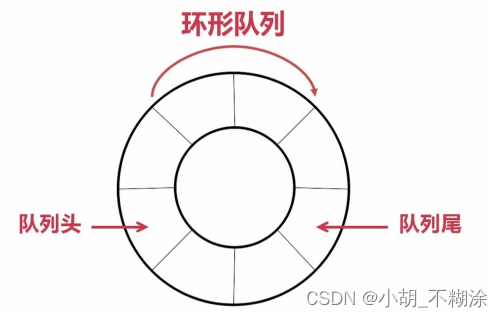
数组下标循环的小技巧- 下标最后再往后(offset 小于 array.length): index = (index + offset) % array.length

- 下标最前再往前(offset 小于 array.length): index = (index + array.length - offset) %array.length
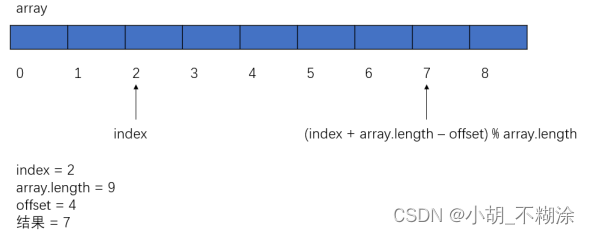
如何区分空与满?
- 通过添加 size 属性记录
- 保留一个位置
- 使用标记
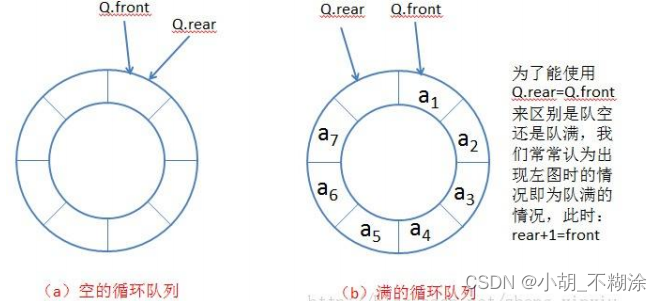
循环队列的实现:
class MyCircularQueue { public int[] elem; public int front;//队头 public int rear;//队尾 public MyCircularQueue(int k) { elem = new int[k+1]; } //队尾入队 public boolean enQueue(int value) { if(isFull()) { return false; } elem[rear] = value; rear = (rear+1) % elem.length; return true; } //队头出队 public boolean deQueue() { if(isEmpty()) { return false; } front = (front+1) % elem.length; return true; } //得到队头元素 public int Front() { if(isEmpty()) { return -1; } return elem[front]; } //得到队尾元素 public int Rear() { if(isEmpty()) { return -1; } int index = (rear == 0) ? elem.length-1 : rear-1; return elem[index]; } public boolean isEmpty() { return front == rear; } public boolean isFull() { return (rear+1)%elem.length == front; } }- 1
- 2
- 3
- 4
- 5
- 6
- 7
- 8
- 9
- 10
- 11
- 12
- 13
- 14
- 15
- 16
- 17
- 18
- 19
- 20
- 21
- 22
- 23
- 24
- 25
- 26
- 27
- 28
- 29
- 30
- 31
- 32
- 33
- 34
- 35
- 36
- 37
- 38
- 39
- 40
- 41
- 42
- 43
- 44
- 45
- 46
- 47
- 48
- 49
- 50
- 51
5. 双端队列(Deque)
**双端队列(deque)**是指允许两端都可以进行入队和出队操作的队列。

Deque是一个接口,使用时必须创建LinkedList的对象: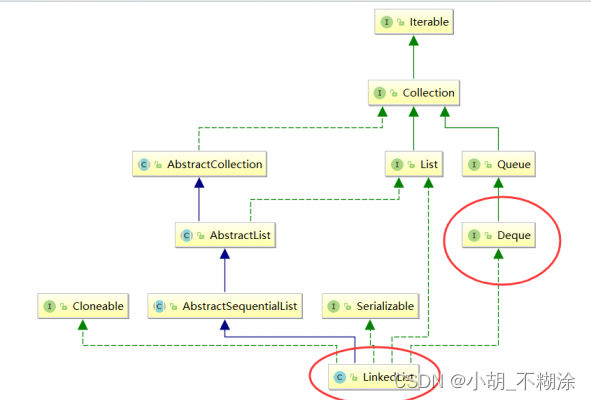
在实际工程中,使用Deque接口是比较多的,栈和队列均可以使用该接口:Deque<Integer> stack = new ArrayDeque<>();//双端队列的线性实现 Deque<Integer> queue = new LinkedList<>();//双端队列的链式实现- 1
- 2
-
相关阅读:
第31讲:MySQL事务的并发问题以及事务的隔离级别
SpringCloud--链路追踪之Sleuth的简单使用
基于Jeecgboot前后端分离的ERP系统开发代码生成(二)
如何正确地把握你与导师的关系
HQL 55 题【持续更新】
forward请求转发
前端学习记录~2023.8.19~JavaScript重难点实例精讲~第7章 ES6(2)
启动mysql报错The server quit without updating PID file
elasticsearch运维_分享两个自己整理的比较好用的elasticsearch脚本
【计算机网络】网络基础(三)
- 原文地址:https://blog.csdn.net/iLoyo_/article/details/133905479
